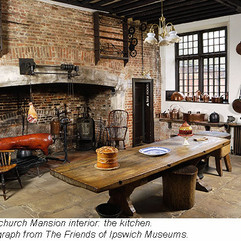CHRISTCHURCH MANSION
Soane Street, Ipswich IP4 2BE
Christchurch Mansion is built on the site of Holy Trinity Priory which was suppressed by Henry VIII in 1536. The extensive agricultural estate changed hands a few times until it was bought by a wealthy merchant called Paul Withypoll, but it was his son, Edmund Withypoll, who completed the house in 1549/50. A Latin motto appears over the front door with the date 1549 and Edmund’s cypher is on the east side with the date 1550.

Despite Edmund having 19 children, within a few generations it came down to one heiress, Elizabeth Withypoll, who inherited the house from her father in 1645. Elizabeth married Leicester Devereux, 6th Viscount Hereford, who was a descendant of the Earls of Essex. The property remained in the Devereux family until 1735 when a French Hugenot named Claude Fonnereau acquired the house for his son, Thomas.
The Fonnereau family lived there until the end of the 19th century, when their fortunes declined so the Mansion was put up for sale and the contents sold. It was bought by a property syndicate who had plans to demolish the Mansion and build on the site. Felix Cobbold, a member of the brewing family of Ipswich, bought the house and gave it to the people of Ipswich on condition the Corporation (as it was then) bought the rest of the park to go with it. Thanks to Felix Cobbold, Christchurch Mansion has been a museum and art gallery since 1896 and his portrait has pride of place in the Great Hall. The Wolsey Gallery and Tudor rooms were added to the original building in 1930.
The Mansion now houses a rich and important collection of art, furniture and objects from the 16th to the 20th century and boasts the largest collection of works by John Constable outside of London.
The Friends of Ipswich Museums conduct guided tours of Christchurch Mansion which can be booked via their website (link below).
[Source: The Friends of Ipswich Museums]
Links: The Friends of Ipswich Museums; Historic England listing; Colchester & Ipswich Museums














